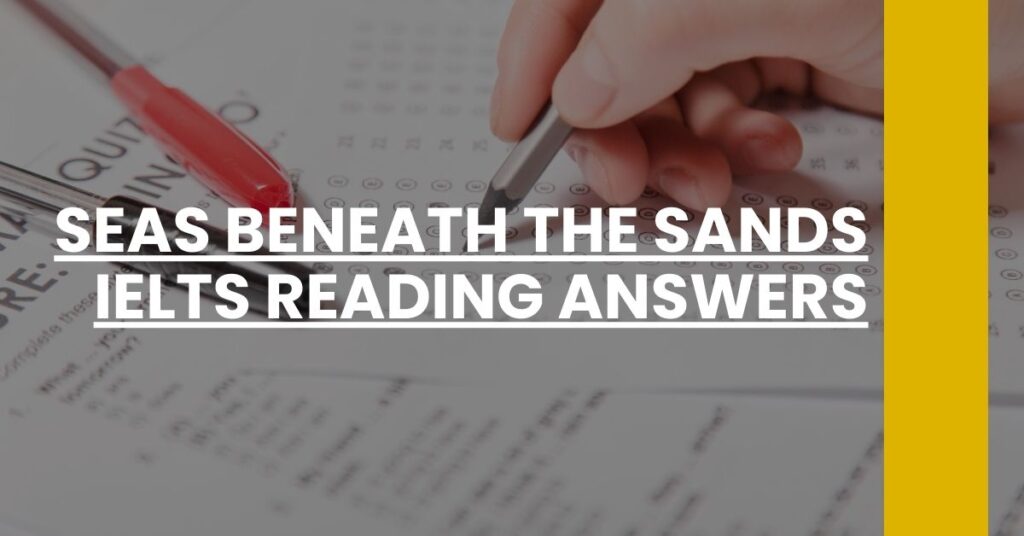Discover the key to Seas Beneath the Sands IELTS reading answers and elevate your test performance.
- Unlock IELTS Reading Answers: Master the techniques to accurately find answers in the “Seas Beneath the Sands” passage.
- Enhance Comprehension Skills: Boost your understanding of IELTS reading materials with focused strategies.
- Effective Time Management: Learn to manage your reading section time smartly, ensuring you cover all questions.
Secure your best score with our guide on Seas Beneath the Sands IELTS reading answers.
- Understanding the “Seas Beneath the Sands” Passage
- Analyzing Question Types and Answer Strategies
- Common Themes and Keywords in “Seas Beneath the Sands”
- Tips for Efficient Passage Skimming and Scanning
- Enhancing Reading Comprehension for IELTS
- The Role of Context in Determining the Right Answers
- Time Management for the Reading Section
- Practicing with “Seas Beneath the Sands”-like Passages
- Utilizing Additional IELTS Learning Resources
- Conclusion and Final Thoughts
Understanding the “Seas Beneath the Sands” Passage
When you’re prepping for the IELTS reading section, you may come across a passage titled “Seas Beneath the Sands.” It’s the kind of reading that can challenge even seasoned test-takers with its complex ideas and layered information. Here’s what you might want to know about this intriguing passage and how it’s set up to test your reading and comprehension skills.
The Big Picture
The “Seas Beneath the Sands” passage delves into the fascinating subject of ancient bodies of water hidden beneath desert sands. Understanding the core idea of the passage is essential, as it can guide you when answering questions related to the main theme. Typically, you’ll find questions that range from fact-based ones to those that ask you to interpret the author’s viewpoints.
Navigating the Questions
Prepping for the “Seas Beneath the Sands” often includes becoming familiar with:
- True/False/Not Given: These questions test your ability to identify factual information.
- Multiple-choice: Here, you need to interpret the text to select the correct option.
- Matching headings: This type asks you to link specific paragraphs to their correct headings, often testing understanding of the main ideas presented.
Take heart: each question type has its own strategy, and we’ll explore them as we traverse through this guide.
Analyzing Question Types and Answer Strategies
There’s no denying that different questions in the IELTS reading test require tailored approaches. Let’s dig into some tactics to tackle questions you might find in “Seas Beneath the Sands.”
True/False/Not Given
Treat these questions as a mini investigation:
- Identify key phrases in the question prompt.
- Search for these phrases within the passage.
- Read around the phrases to understand the context.
- Determine the answer based on whether the statement is supported, contradicted, or not covered.
Remember, don’t let your pre-existing knowledge sway you. Stick to what the passage says.
Multiple-choice Questions
Here, reading comprehension is key:
- Understand the question completely before looking at the options.
- Eliminate the most obvious wrong choices to narrow down your options.
- Look for synonyms and paraphrased sentences in the text that match the remaining alternatives.
Matching Headings
When approaching this task, keep a clear head:
- Skim the paragraph first: Get a good grasp of the gist.
- Identify key themes: Pay attention to topic sentences.
- Choose headings: Match them to the main idea of each paragraph.
A systematic approach is your best friend here.
Common Themes and Keywords in “Seas Beneath the Sands”
Latching onto themes and crucial vocabulary is a skill that will serve you well, not just for “Seas Beneath the Sands” but for the IELTS reading test in general.
Discovering the Core Themes
The passage is likely to explore themes around:
- Geographical phenomena: Ranging from descriptions of landscapes to climatic conditions.
- Historical and archaeological perspectives: How these hidden seas have been studied.
- Ecological implications: The role these subsurface reservoirs play in the ecosystem.
Locating these themes helps to anticipate the types of questions that may arise.
Keywords: Your Guiding Stars
Recognize that keywords are potent signposts that can lead you to the right answers. Keep an eye out for:
- Scientific terms: Specific vocabulary related to geology or archaeology.
- Dates and figures: Numeric data is often tied to key points.
- Names and places: These nouns are commonly questioned or used to distract you.
Pro Tip: Jot down or mentally note these keywords as you read – they’re like breadcrumbs leading you back to crucial information.
Tips for Efficient Passage Skimming and Scanning
Knowing how to work quickly through a passage, like “Seas Beneath the Sands,” to pick up essential details is a skill that saves you precious minutes during the exam. Let’s cut to the chase for effective skimming and scanning.
Streamline Your Skimming
Your skimming should allow you to:
- Gather the general idea: Understand the big picture without getting bogged down by details.
- Identify the structure: Know how the passage is organized to facilitate quick navigation.
Master Your Scanning
Scanning should be like a targeted mission:
- Locate specific details: Hone in on names, numbers, and those critical keywords you’ve noted.
- Mark up the text: Use underlining or circling (if the rules allow) to have a visual guide to key information.
By making these techniques second nature, you’ll enter the test calm, collected, and ready to excel.
Enhancing Reading Comprehension for IELTS
As you journey towards acing the IELTS reading section, enhancing your overall reading comprehension is not just a goal—it’s a necessity. Here are some habits that could lift your abilities to new heights.
Cultivate Lifelong Reading Habits
Consistency is key—make reading a daily ritual. Whether it’s newspapers, novels, or scientific journals, the diversity of content will build your comprehension muscles.
Expand Your Lexicon
Words are the lifeblood of comprehension. Learning new words and, more importantly, understanding how they’re used in context, enriches your IELTS preparation.
Practice with Purpose
The IELTS reading test is timed, and so your practice should be too. Set a timer and work through passages. It’s about simulating the test environment to boost your speed and reliability.
Synthesize Information
Work on summarizing paragraphs after you read them. This technique strengthens your capacity to distill information—a skill paramount for ‘Seas Beneath the Sands’ and similar passages.
Analyze Your Mistakes
Lastly, after each practice session, take the time to go over incorrect answers and understand where you went wrong. Each error is an opportunity for learning and growth.
By adopting these habits and actively working to improve your reading comprehension, you’ll find that the daunting task of navigating through complex IELTS passages, such as “Seas Beneath the Sands,” becomes an achievable challenge.
The Role of Context in Determining the Right Answers
Navigating through the Seas Beneath the Sands IELTS reading answers isn’t just about picking out keywords or understanding single sentences in isolation. It’s about grasping the context. Contextual understanding is what gives meaning and cohesion to the information that you’re absorbing.
Uncover Underlying Meanings
Looking at the bigger picture, context helps you to infer meanings and answer questions that aren’t directly stated in the text. It’s about reading between the lines and making connections that are implied rather than explicit.
Interpret Tone and Nuance
You’ll find that the author’s tone and nuances in language can dramatically change the meaning of a text. Identifying shifts in sentiment or perspective through contextual clues is critical in piecing together the correct answers.
Use Surrounding Information
A single line in the Seas Beneath the Sands passage can hold multiple connotations, and it’s the surrounding sentences that anchor its true intent. When you’re stumped by a tricky question, look at the statements before and after to guide your interpretation.
Remember: The right answer often lies in your ability to connect the dots across paragraphs, so keep your eyes open for links and transitions that paint the complete picture.
Time Management for the Reading Section
The IELTS reading section is a race against the clock, and time management plays an integral role in ensuring you’re able to uncover all the Seas Beneath the Sands IELTS reading answers efficiently.
Prioritize Questions Wisely
Consider which questions to tackle first. Some argue for a straightforward approach, starting at the beginning and moving sequentially. However, others recommend addressing types of questions that align with your strengths early on to secure quick wins and build confidence.
Allocate Your Minutes
Decide how much time you’ll allot to each type of question. It’s a balance between being thorough and being swift. Sticking to a rough schedule can prevent you from getting bogged down in any one section.
- Skimming and Reading: Approximately 3-5 minutes to get the gist.
- Answering Questions: Around 1 minute per question for straightforward ones and 2-3 minutes for more complex questions.
Keep Track of Time
Don’t let time slip away. Whether you wear a watch or keep an eye on the clock in the exam room, being aware of the time you have remaining is essential in pacing yourself effectively.
Practicing with “Seas Beneath the Sands”-like Passages
To truly prepare for the challenge of unlocking Seas Beneath the Sands IELTS reading answers, you must dive into practice with similar passages. It’s the relentless drilling with a variety of texts that will carve out your path to excellence.
Immerse in Diverse Topics
Cultivate a habit of reading academic articles across different subjects – from geography to history. Online educational platforms offer a diverse set of reading materials that can elevate your preparation.
Simulate Exam Conditions
Mimic the pressure of the real exam by timing your practice sessions. This isn’t just about tracking your progress, but also about conditioning yourself to the rigors of the test situation.
Reflect on Your Performance
Beyond practicing, take the time to analyze your answers. Understanding why a particular response is correct or incorrect can provide deep insights into improving your strategies.
Utilizing Additional IELTS Learning Resources
To further enhance your proficiency in navigating the IELTS reading passages like “Seas Beneath the Sands,” take advantage of available learning resources that can sharpen your skills and strategy.
- Online Practice Tests: These can give you a feel for the real test environment. Official sources like the IELTS Progress Check offer comprehensive materials and feedback on your performance.
- Reading Comprehension Platforms: Expand your reading ability through platforms offering exercises tailored to your level and progress, like ReadTheory.
- IELTS Preparation Books: These can be invaluable resources that provide targeted practice with well-explained answers to guide your learning journey.
Each resource will add a layer of richness to your preparation, exposing you to a breadth of language and ideas that will undoubtedly serve you well on test day.
Conclusion and Final Thoughts
Honing in on the Seas Beneath the Sands IELTS reading answers requires a multifaceted approach. It’s not just about practising with texts or honing in on keywords – it’s a nuanced blend of strategic preparation, time management, and the ability to pull together contextual clues into a coherent understanding.
As you embark on your IELTS journey, keep in mind that your goal isn’t simply to find quick answers. It’s to build a robust foundation in critical reading skills that will serve you far beyond the test, into your academic and professional life.
With each practice session, you’re not just preparing for a test – you’re cultivating a skillset. And the beauty lies in the fact that these skills, once obtained, are yours to keep, opening doors to opportunities and empowering your communication prowess in an interconnected world. So, persevere, practice wisely, and go into your IELTS with the assurance that you have done what it takes to succeed.
Explore “Seas Beneath the Sands” IELTS reading answers guide for effective strategies, comprehension tips, and question-solving techniques.

